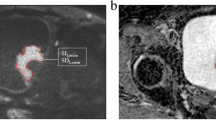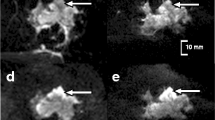Abstract
Objectives
To evaluate whether readout-segmented echo-planar imaging (RS-EPI) diffusion weighted image (DWI) can diminish image distortion in the head and neck area, compared with single-shot (SS)-EPI DWI.
Methods
We conducted phantom and patient studies using 3 T magnetic resonance imaging (MRI) with a 16-channel coil. For the phantom study, we evaluated distortion and signal homogeneity in gel phantoms. For the patient study, 29 consecutive patients with clinically suspicious parotid lesions were prospectively enrolled. RS-EPI and SS-EPI DWI were evaluated by two independent readers for identification of organ/lesion and distortion, using semiquantitative scales and quantitative scores. Apparent diffusion coefficient (ADC) values and contrast-noise ratios of parotid tumours (if present; n = 15) were also compared.
Results
The phantom experiments showed that RS-EPI provided less distorted and more homogeneous ADC maps than SS-EPI. In the patient study, RS-EPI was found to provide significantly less distortion in almost all organs/lesions (p < 0.05), according to both semiquantitative scales and quantitative scores. There was no significant difference in ADC values and contrast-noise ratios between the two DWI techniques.
Conclusions
The distortion in DWI was significantly reduced with RS-EPI in both phantom and patient studies. The RS-EPI technique provided more homogenous images than SS-EPI, and can potentially offer higher image quality in the head and neck area.
Key Points
• The distortion in DWI is significantly reduced with RS-EPI compared with SS-EPI.
• Structures in the head and neck were identified more clearly using RS-EPI.
• No significant difference in ADC values was found between the techniques.





Similar content being viewed by others
Abbreviations
- ADC:
-
apparent diffusion coefficient
- DWI:
-
diffusion weighted imaging
- EPI:
-
echo-planner imaging
- ICC:
-
interclass correlation
- PROPELLER:
-
periodically rotated overlapping parallel lines with enhanced reconstruction
- SD:
-
standard deviation
- SS:
-
single-shot
- ROI:
-
region of interest
- RS:
-
readout–segmented
- GRAPPA:
-
generalized autocalibrating partially parallel acquisition
References
Le Bihan D (2003) Looking into the functional architecture of the brain with diffusion MRI. Nat Rev Neurosci 4:469–480
Thoeny HC, De Keyzer F, Boesch C, Hermans R (2004) Diffusion-weighted imaging of the parotid gland: Influence of the choice of b-values on the apparent diffusion coefficient value. J Magn Reson Imaging 20:786–790
Yoshino N, Yamada I, Ohbayashi N et al (2001) Salivary glands and lesions: evaluation of apparent diffusion coefficients with split-echo diffusion-weighted MR imaging—initial results. Radiology 221:837–842
Juan CJ, Chang HC, Hsueh CJ et al (2009) Salivary glands: echo-planar versus PROPELLER Diffusion-weighted MR imaging for assessment of ADCs. Radiology 253:144–152
Eida S, Sumi M, Sakihama N, Takahashi H, Nakamura T (2007) Apparent diffusion coefficient mapping of salivary gland tumors: prediction of the benignancy and malignancy. AJNR Am J Neuroradiol 28:116–121
Habermann CR, Arndt C, Graessner J et al (2009) Diffusion-weighted echo-planar MR imaging of primary parotid gland tumors: is a prediction of different histologic subtypes possible? AJNR Am J Neuroradiol 30:591–596
Yabuuchi H, Matsuo Y, Kamitani T et al (2008) Parotid gland tumors: can addition of diffusion-weighted MR imaging to dynamic contrast-enhanced MR imaging improve diagnostic accuracy in characterization? Radiology 249:909–916
Kato H, Kanematsu M, Toida M et al (2011) Salivary gland function evaluated by diffusion-weighted MR imaging with gustatory stimulation: preliminary results. J Magn Reson Imaging 34:904–909
Klinke T, Daboul A, Maron J et al (2012) Artifacts in magnetic resonance imaging and computed tomography caused by dental materials. PLoS One 7:e31766
Porter DA, Heidemann RM (2009) High resolution diffusion-weighted imaging using readout-segmented echo-planar imaging, parallel imaging and a two-dimensional navigator-based reacquisition. Magn Reson Med 62:468–475
Bogner W, Pinker-Domenig K, Bickel H et al (2012) Readout-segmented echo-planar imaging improves the diagnostic performance of diffusion-weighted MR breast examinations at 3.0 T. Radiology 263:64–76
Iima M, Yamamoto A, Brion V et al (2012) Reduced-distortion diffusion MRI of the craniovertebral junction. AJNR Am J Neuroradiol 33:1321–1325
Lavdas I, Behan KC, Papadaki A, McRobbie DW, Aboagye EO (2013) A phantom for diffusion-weighted MRI (DW-MRI). J Magn Reson Imaging 38:173–179
Fleiss JL, Levin B, Paik MC (2003) Statistical methods for rates and proportions, 3rd edn. John Wiley & Sons, New York
Witt RL (2002) The significance of the margin in parotid surgery for pleomorphic adenoma. Laryngoscope 112:2141–2154
O'Brien CJ (2003) Current management of benign parotid tumors–the role of limited superficial parotidectomy. Head Neck 25:946–952
Parwani AV, Ali SZ (2003) Diagnostic accuracy and pitfalls in fine-needle aspiration interpretation of Warthin tumor. Cancer 99:166–171
Albergotti WG, Nguyen SA, Zenk J, Gillespie MB (2012) Extracapsular dissection for benign parotid tumors: a meta-analysis. Laryngoscope 122:1954–1960
Heller KS, Attie JN (1988) Treatment of Warthin's tumor by enucleation. Am J Surg 156:294–296
Taha MS, Hassan O, Amir M, Taha T, Riad MA (2013) Diffusion-weighted MRI in diagnosing thyroid cartilage invasion in laryngeal carcinoma. Eur Arch Otorhinolaryngol. doi:10.1007/s00405-013-2782-8
Vandecaveye V, de Keyzer F, Vander Poorten V et al (2006) Evaluation of the larynx for tumour recurrence by diffusion-weighted MRI after radiotherapy: initial experience in four cases. Br J Radiol 79:681–687
Takahara T, Hendrikse J, Yamashita T et al (2008) Diffusion-weighted MR neurography of the brachial plexus: feasibility study. Radiology 249:653–660
Yoshikawa T, Hayashi N, Yamamoto S et al (2006) Brachial plexus injury: clinical manifestations, conventional imaging findings, and the latest imaging techniques. Radiographics 26(Suppl 1):S133–S143
Chhabra A, Andreisek G, Soldatos T et al (2011) MR neurography: past, present, and future. AJR Am J Roentgenol 197:583–591
Forbes KP, Pipe JG, Karis JP, Heiserman JE (2002) Improved image quality and detection of acute cerebral infarction with PROPELLER diffusion-weighted MR imaging. Radiology 225:551–555
Iima M, Reynaud O, Tsurugizawa T et al (2014) Characterization of Glioma Microcirculation and Tissue Features Using Intravoxel Incoherent Motion Magnetic Resonance Imaging in a Rat Brain Model. Invest Radiol 49:485–490
Le Bihan D (2013) Apparent diffusion coefficient and beyond: what diffusion MR imaging can tell us about tissue structure. Radiology 268:318–322
Acknowledgments
This report was presented as a Multimedia Electronic Poster at the scientific sessions of the Joint Annual Meeting ISMRM-ESMRMB 2014, in Milan, Italy. We wish to thank Mr Katsutoshi Murata and Mr Masato Uchikoshi, from Siemens Healthcare for their valuable support in the optimization of scan parameters and data acquisition. We would also thank Dr. Masahiro Kikuchi for his useful suggestions as a head and neck surgeon, regarding this study.
The scientific guarantor of this publication is Dr. Kaori Togashi, Department of Diagnostic Imaging and Nuclear Medicine, Graduate School of Medicine, Kyoto University, Kyoto, Japan.
The authors of this manuscript declare relationships with the following companies: David A. Porter is an employee of Siemens AG, Erlangen, Germany. This study has received funding by a Grant-in-Aid for JSPS Fellows from the Japan Society for the Promotion of Science (Sho Koyasu, Mami Iima). No complex statistical methods were necessary for this paper. Institutional Review Board approval was obtained. Written informed consent was obtained from all subjects (patients) in this study. None of study subjects or cohorts have been previously reported. Methodology: prospective, observational study, performed at one institution.
Author information
Authors and Affiliations
Corresponding author
Rights and permissions
About this article
Cite this article
Koyasu, S., Iima, M., Umeoka, S. et al. The clinical utility of reduced-distortion readout-segmented echo-planar imaging in the head and neck region: initial experience. Eur Radiol 24, 3088–3096 (2014). https://doi.org/10.1007/s00330-014-3369-5
Received:
Revised:
Accepted:
Published:
Issue Date:
DOI: https://doi.org/10.1007/s00330-014-3369-5




